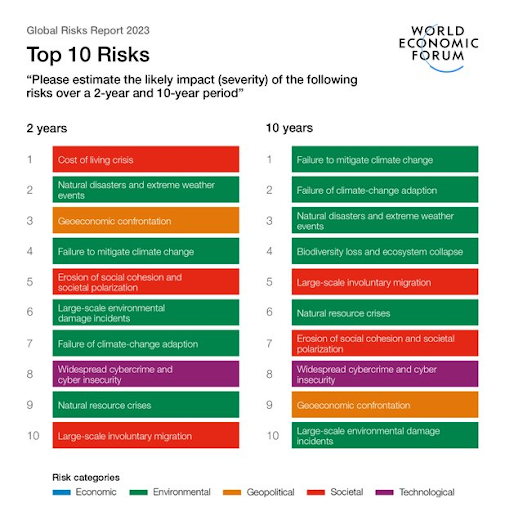In news– Global Risks Report 2023 has been released by the World Economic Forum (WEF) recently.
Key findings of the report-
- The WEF report has been released ahead of the organisation’s flagship annual meeting. This year, it is titled as Cooperation in a Fragmented World and will be held from January 16-20, 2023 at the Swiss resort of Davos.
- According to this report, ‘Natural disasters and extreme weather events’ is the second-most severe risk that the world needs to be prepared for in the next two years.
- It alerted that over the next 10 years or by 2033, the interconnections between biodiversity loss, pollution, natural resource consumption, climate change and socioeconomic drivers will make for a dangerous mix.
- In the meantime, the current global pandemic and war in Europe has been held responsible for the energy, inflation and food crises. In fact, ‘cost of living’ ranks as the top most serious global risk in the short term (over the next two years).
- ‘Global risk’ is defined as the possibility of the occurrence of an event or condition which, if it occurs, would negatively impact a significant proportion of global gross domestic product, population or natural resources, according to the WEF.
- The findings by the WEF are concerning since the impact of natural disasters or extreme weather events disproportionately affects low- and middle-income countries.
- Such events figure among the top five risks in 25 countries, especially developing coastal countries across Latin America, Africa and South-East Asia including India.
- In 10 countries, natural disasters and extreme weather events were perceived to be the top most severe risk in the short term or in the next two years.
- The world has struggled to make the required progress on climate change despite 30 years of global climate advocacy and diplomacy, the WEF report flagged.
- This has been reflected in the WEF Global Risks Report itself for a decade now. ‘Failure on climate action to address climate change’ has continued to figure among the top risks in the report since 2011.
- It also warned that the world may see a ‘polycrisis’ centred around natural resource shortages by 2030.
- The report was produced in partnership with Marsh McLennan and Zurich Insurance Group.

What is a polycrisis?
- While the word polycrisis has been around for long, it has gained traction in the past year. Columbia University historian Adam Tooze is perhaps the most prominent champion of the polycrisis label.
- His explanation of the term is: A problem becomes a crisis when it challenges our ability to cope and thus threatens our identity.
- In the polycrisis the shocks are disparate, but they interact so that the whole is even more overwhelming than the sum of the parts.
- Another explanation of polycrisis would be — when multiple crises in multiple global systems become causally entangled in ways that significantly degrade humanity’s prospects.
- These interacting crises produce harms greater than the sum of those the crises would produce in isolation, were their host systems not so deeply interconnected.
- The term polycrisis was first used in the 1990s by French theorist of complexity Edgar Morin.
















